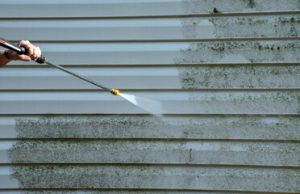Power washing uses pressurized water to blast away dirt, mildew, grime, and other unwanted substances. However, it is important to point the nozzles away from people and animals as the force of the water could cut them.

Cleaning a building’s exterior surfaces prevents harmful contaminants like pollen and mold from latching onto them. In addition, regular pressure washing helps maintain a property’s value and safety. Visit https://www.certifiedsoftwash.ca/ to learn more.
The appearance of your home, business, and outdoor spaces makes an important first impression on guests, customers, or potential buyers. Pressure washing removes dirt, mildew, moss, and other organic buildup, making your property look cleaner, brighter, and more well-maintained.
Regular outdoor cleaning prevents deterioration of surfaces like siding, roofs, driveways, and walkways. Mold, mildew, moss, pollen, and other organic growth not only diminish the visual appeal of your exterior, but they can also trap moisture and lead to weakened shingles or rotted wood. Pressure washing removes these elements and extends the life of your surfaces.
A clean exterior reflects a well-maintained property and supports higher resale value. Boosting your curb appeal by having professional pressure washing services remove oil stains, mold spores, and other unsightly marks improves the look of your home and draws in more interested buyers during open houses.
Pressure washing can remove a wide variety of difficult stains that ordinary hoses and cleaning methods struggle with. Using heat, detergent, and a powerful stream of pressurized water, pressure washing removes stubborn marks and stains that can damage surfaces if left unattended.
In addition to improving the look of your property, regular pressure washing helps reduce slip and fall risks. Algae, mildew, and moss on sidewalks, patios, and driveways create slippery conditions that pose safety risks for pedestrians. Pressure washing these areas regularly removes these substances, reducing the risk of accidents and creating safer environments for your family or employees.
If you want to transform the look of your residential or commercial property, pressure washing is an effective and affordable solution. Hiring a professional ensures that the job is completed correctly, and it saves you time and hassle from renting equipment or learning how to use it yourself. Whether you need to clean your siding, patio, or walkways, SP Construction LLC can provide thorough, efficient, and high-quality cleaning services that will leave your property looking great. Contact us today to schedule an appointment. We offer free estimates and a 100% customer satisfaction guarantee. We’re proud to be a locally owned and operated pressure washing service.
Health
Professional pressure washing services remove harmful contaminants like mildew, mold, and dirt from surfaces, promoting a healthier living environment. The forceful water stream can reach deep into porous materials and crevices, ensuring thorough cleaning. Regular power washing also extends the life of outdoor structures and surfaces by preventing damage caused by weather or debris.
Dirt, mildew, and algae growth can irritate skin and eyes, trigger asthma and allergies, and cause other health concerns. In addition, slick surfaces created by these contaminants pose a safety risk for pedestrians. Adding a professional pressure wash to your spring cleaning routine eliminates these dangers, enhancing the health and safety of family members, guests, and pets.
Aside from enhancing curb appeal, professionally cleaned exteriors can increase your home’s value. Accumulated dirt, grime, and debris deteriorate the structure of homes over time. Regular cleaning with a high-pressure washer can restore and prolong the life of surfaces, saving homeowners and businesses money on repairs and replacements.
When choosing a pressure washing service, look for one with a solid reputation and track record. They should be able to provide references from past clients and be willing to show you before-and-after pictures of their work. In addition, ensure the company has liability insurance, as accidents can happen.
The equipment used for pressure washing can be dangerous, posing hazards to the operator and bystanders. Direct contact with the high-pressure water stream can pierce skin, leading to severe wounds that require medical attention. The powerful water jet can also strip paint and etch delicate surfaces. It can even cause electrical shock if it comes into contact with exposed outlets or cords.
To avoid injuries, choose a qualified professional who is experienced with the equipment and knows how to adjust the PSI settings based on the surface being cleaned. Be sure to test the water flow on an inconspicuous area before using, and always wear protective gear such as goggles, gloves, and closed-toe shoes. Make sure the technician covers or shields any objects not intended to be sprayed, and keeps the nozzle at least 12 inches away from surfaces.
Safety
Pressure washing is an effective cleaning method for a variety of surfaces, including siding, driveways, patios, and decks. However, it can also be dangerous if improperly handled or used. This is why it’s important to hire a professional to perform the service. They can ensure the proper psi, water rotation, and cleaning products are used, as well as test the surface before applying the high-pressure spray. This will help prevent the surface from deteriorating and killing surrounding vegetation, as well as protect the health of the home’s inhabitants.
Before using a pressure washer, it’s important to read the manual and understand how the equipment works. Different models have different nozzles, pressure settings, and operating procedures that must be followed to ensure safe use. For example, the distance and angle of the nozzle is critical; too close or at the wrong angle can damage surfaces. It’s also essential to clear the workspace of furniture, decorations, or other objects that could be damaged by the spray. Similarly, it’s important to check overhead power lines to make sure you don’t inadvertently spray them with water.
When properly used, a pressure washer can effectively clean surfaces in a fraction of the time it takes to do so by hand. But like any tool, it can cause harm when misused. Injury risks include high-pressure wounds, which can pierce skin and create deep cuts that require medical attention. Flying debris can be a hazard as well, as loose rock or paint chips become projectiles that may strike and injure people nearby. Electrical hazards are another concern, as contact with exposed outlets or cords can lead to severe shock.
A professional will have the training and knowledge necessary to safely operate a pressure washer. They will understand the proper psi, water rotation, nozzle size, and cleaning products to use for every surface type. They will also know how to properly store the equipment and take steps to avoid potential electrical hazards. In addition, a professional will always be mindful of the environmental impact of their work, ensuring that wastewater is contained and disposed of in accordance with local regulations.
Environment
Using a pressure washer is an effective and efficient way to clean surfaces, but the equipment can pose environmental concerns. Many gas-powered models emit greenhouse gases directly into the atmosphere, while electric-powered machines still leave a significant carbon footprint based on how the electricity is generated. However, water conservation techniques can mitigate these impacts. For example, a pre-soaking treatment can reduce the amount of water needed for a complete cleaning, and water collection and recycling systems allow for water reuse.
The use of environmentally friendly detergents is another simple measure that makes a big difference. Choosing biodegradable options that are free from chemicals such as chlorine and phosphates is also important, as these products break down naturally without leaving harmful residues that can be ingested by local plants and animals. Additionally, using a pressure washer with adjustable spray capabilities can minimize splashing and direct the flow of water where it is needed most, further reducing the impact on the environment.
Before getting started, it is essential to identify sensitive areas and understand how the pressure washing process may affect them. For instance, plants and other outdoor features can be protected with plastic sheets or wetted down to avoid damage from the high-pressure water and chemicals. Barriers can also be put in place to prevent debris from being carried offsite by the water runoff, further minimizing environmental impact.
Professionals are also equipped with the right tools to ensure a thorough yet gentle clean. They have access to commercial-grade equipment that is not available to the average homeowner, allowing them to tackle stubborn grime buildup and restore the luster of pavers, driveways, patios, and more. A professional will be able to dislodge deeply-ingrained dirt and mildew, leaving surfaces looking spotless and revitalized.
Regular pressure washing is a great way to improve the appearance of your home or business, but it’s also an excellent way to protect your health and maintain your property’s value. Dirty and stained exterior surfaces harbor bacteria that can cause illness. Mold and mildew spores can lead to allergies, coughing, sneezing, and other respiratory issues. Pressure washing removes these contaminants, promoting healthier indoor air quality and extending the lifespan of your siding, roof, and outdoor furniture.




